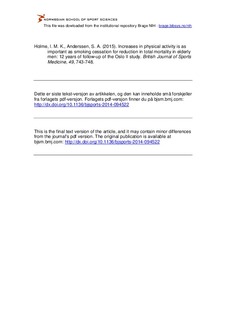| dc.contributor.author | Holme, Ingar Morten K. | |
| dc.contributor.author | Anderssen, Sigmund Alfred | |
| dc.date.accessioned | 2016-05-25T09:47:52Z | |
| dc.date.available | 2016-05-25T09:47:52Z | |
| dc.date.issued | 2015-05-14 | |
| dc.identifier.citation | British Journal of Sports Medicine. 2015, 49, 743-748 | nb_NO |
| dc.identifier.uri | http://hdl.handle.net/11250/2390314 | |
| dc.description | Dette er siste tekst-versjon av artikkelen, og den kan inneholde små forskjeller fra forlagets pdf-versjon. Forlagets pdf-versjon finner du på bjsm.bmj.com: http://dx.doi.org/10.1136/bjsports-2014-094522 / This is the final text version of the article, and it may contain minor differences from the journal's pdf version. The original publication is available at bjsm.bmj.com: http://dx.doi.org/10.1136/bjsports-2014-094522 | nb_NO |
| dc.description.abstract | Background: Physical activity (PA) at leisure by the elderly, and its relationship to cardiovascular (CV) and non-CV mortality, with and without competing risk, has been scarcely described. We determined the relationships between PA, smoking and 12-year CV, non-CV and all-cause mortality in elderly Oslo men screened for CV disease in 1972–1973 and 2000.
Methods: Among 14 846 men born during 1923–1932 and participating in 1972–1973, there were 5738 participants in 2000. During the 12 years follow-up 2154 died. Cox regression modelling of mortality endpoints, with and without competing risk, was applied analysing PA variables hours per week of light or vigorous PA intensity and degree of PA at leisure. Comparisons of predictive ability between PA and smoking were done by receiver operating characteristics.
Results: Thirty minutes of PA per 6 days a week was associated with about 40% mortality risk reduction. There was a 5 years increased lifetime when comparing sedentary and moderate to vigorous physically active men. Associations to CV or non-CV mortality were slightly weakened, allowing competing risk. Conditional on the prevalence of smoking and PA, the degree of PA at leisure was almost as predictive as smoking with regard to the effects on mortality. Increase in PA was as beneficial as smoking cessation in reducing mortality.
Conclusions: Even at the age of 73 years, PA is associated highly with mortality between groups of sedentary and active persons. Allowing for competing risk did not weaken these associations markedly. Public health strategies in elderly men should include efforts to increase PA in line with efforts to reduce smoking behaviour. | nb_NO |
| dc.language.iso | eng | nb_NO |
| dc.publisher | BMJ Publishing Group | nb_NO |
| dc.subject | physical activity | nb_NO |
| dc.subject | smoking | nb_NO |
| dc.subject | cardiovascular disease | nb_NO |
| dc.subject | mortality | nb_NO |
| dc.subject | competing risk | nb_NO |
| dc.title | Increases in physical activity is as important as smoking cessation for reduction in total mortality in elderly men: 12 years of follow-up of the Oslo II study | nb_NO |
| dc.type | Journal article | nb_NO |
| dc.type | Peer reviewed | nb_NO |
| dc.subject.nsi | VDP::Social science: 200 | nb_NO |
| dc.subject.nsi | VDP::Social science: 200::Social science in sports: 330 | nb_NO |
| dc.subject.nsi | VDP::Social science: 200::Social science in sports: 330::Other subjects within physical education: 339 | nb_NO |
| dc.source.journal | British Journal of Sports Medicine | nb_NO |
| dc.description.localcode | Seksjon for idrettsmedisinske fag / Department of Sport Medicine | nb_NO |
